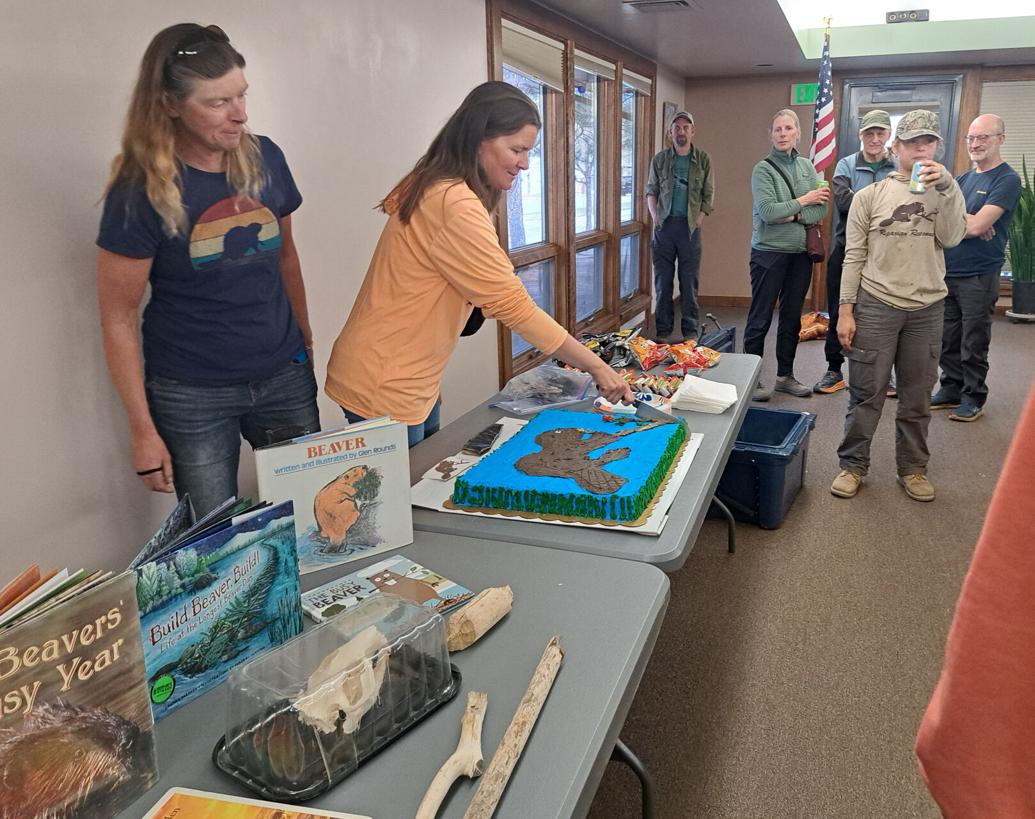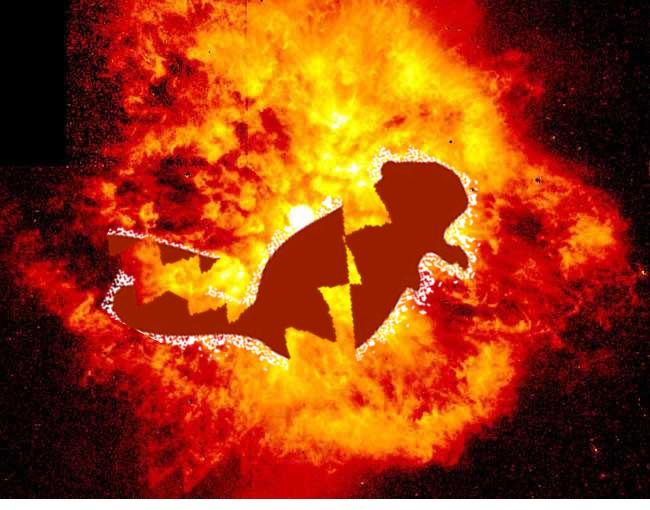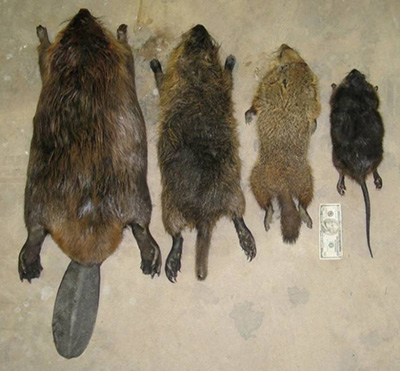I was very happy to see this weeks paddle. Watch closely and see if you can identify the mysterious visitors. The spotted wildboar piglets are a special treat.
All of Colorado is just bursting at the beaver seams. In addition to hosting their own beavercon this year, and their first beaver festival this summer, they are working hard to let actual beavers do their actual jobs.
Leave it to Beavers: Cross-species collaboration may help restore wetlands
 Envision Chaffee County held a conversation on Apr. 23 with the leader of an ecological initiative that hopes to restore wetlands in the Fourmile Creek area, which, in addition to restoring biodiversity in the region, may prevent sediment from accumulating in downstream reservoirs.
Envision Chaffee County held a conversation on Apr. 23 with the leader of an ecological initiative that hopes to restore wetlands in the Fourmile Creek area, which, in addition to restoring biodiversity in the region, may prevent sediment from accumulating in downstream reservoirs.
Ecologist Mark Beardsley, principal with EcoMetrics and the Colorado Open Lands project Riparian Reconnect, shared his enthusiasm for the hydrological engineers of rodentdom at a talk at the Buena Vista Community Center on April 23.
“We said, gosh, how can we control all the sediment coming down into the Arkansas River? Because that sediment sometimes kills fish and kills aquatic bugs and fills up reservoirs with gunk,” said Envision Chaffee County executive director Cindy Williams. “Mark helped us figure out that really the best way to control sediment is to enhance wetland using beavers … We’re super excited about the project. I mean, big picture. I think this is probably the most notable and the coolest project of its kind in the state of Colorado. It’s given a lot of attention from all over the state, from a lot of people. It’s an opportunity to prove that this really works.”
Beardsley said that he initially expected to see resistance to wetlands restoration from owners of large water rights, as wetlands lead to greater evaporative water loss compared to simple streams.
“The fact that these sediment dynamics are in play and these trapping mechanisms are there has gotten the attention of very important people, the types of people that originally scared me as people that wouldn’t be interested in this,” Beardsley said. “Colorado Springs Water, Denver Water, (Northern Colorado Water Conservancy District), these people are all in, starting to invest in headwaters restoration and restoration of this type.”
A “majestic animal” in Beardsley’s eye, beavers are awkward on dry land but highly adapted to living in the water. A keystone species, they engineer their environment to suit their needs. When they build dams in simple streams, the water pools and floods outward rather than continuing to deeply incise a single narrow channel in the earth, raising the water table and allowing a riparian ecosystem to thrive.
Let beavers make their way in YOUR world too. They leave some truly epic footprints.
“These high elevation streams and wetlands wouldn’t be what they could be if it wasn’t for beavers. That point became exceedingly obvious the longer I spent looking at them,” Beardsley said.
When Europeans came to North America, they began hunting beavers for their thick pelts. The fur trade was a prime driver in the expansion westward and the North American Beavers were hunted nearly to extinction. Beardsley compared the extirpation of beavers to that of the bison.
The demand for beaver fur waned as silk began to replace it and beavers slowly but surely began to return. That brought them into conflict with humans.
“Other than humans, I’d say beavers are probably the most adept animals at changing their environment for their own use. They’re good. We call them ecological engineers. And so many other living things have adapted to live with the work that beavers do. But they don’t know that the areas that they’re coming back to, we may have already got other ideas about how that should be managed,” Beardsley said. “We’ve grown up with generations now that are thinking of these animals as pests, as nuisance animals. And they’re kind of still sort of classified that way, according to the state of Colorado.”
Beardsley hopes that the human-beaver relationship can move on from competition to collaboration, with people relying on the large rodents “as partners to restore some of these waterways that have become damaged.”
“This activity – building dams, blocking of water – that gives them these places where they can swim and get from food to shelter and all these places they need to go without having to waddle around like an awkward duck,” Beardsley said. “I almost said we could take advantage of that, as wetland restoration practitioners, and we kind of do, but I like to think of it as we partner with them. They get to do what they want to do. We get something out of it too.”
It’s a win-win whenever you cooperate with beavers. That’s for certain.
Not only do the dams capture sediment, but the wetlands they create can also help contain wildfires.
“Joe Wheaton, a famous beaver scientist, explains that very complicated thing in three words: ‘Water doesn’t burn’,” Beardsley said.
How would Joe the hydrologist feel about being called a famous beaver scientist? Well he’d like the word famous anyway.
Because of this, wetlands act as safe havens for animals during wildfires.
“This is the place where you hide, if you’re an animal. This is what spawns back, the regeneration of these habitats,” Beardsley said.
What EcoMetrics has been doing in Fourmile over the past several years is beaver mimicry: building beaver-like dams in waterways like Fourmile Creek to create wetlands and, more importantly, to invite beavers back into the area to build their own dams, showing the primates how it’s done.
Using historical aerial photography, Beardsley can infer where beaver populations are along Fourmile Creek and its tributaries by identifying the ecological footprint of beaver dams and lodges. He has identified 22 sites in Chaffee County that were once beaver habitats that are ripe for restoration.
“Our aim is, with Colorado Open Lands, to develop up to six projects to start moving forward on in the future,” Beardsley said. He’s been working on the Fourmile watershed project since 2017.
The impact of this kind of work over time can be seen along the road over Trout Creek, whose riparian zone was restored through a project by the Civilian Conservation Corps in 1933.
Before the project, the area around Trout Creek was described “as this completely denuded, decimated, destroyed landscape,” Beardsley said. A team of hundreds of workers built thousands of small dams along the waterway.
“Then they were seeding it, and they were riparian planting,” Beardsley said. “Another reason I think it worked is because beavers found it, and beavers keep finding it, and they’re maintaining it now.”
Here, we’ll take it from here Mark.To quote a famous beaver scientist, “Let the rodent do the work.”
Enos Mills would be so proud!
 One of the finest tools frequently used against beavers is the misunderstanding of population. People opposed to them say that they must be trapped or their population will explode. Leading to my favorite graphic ever created on this website years ago.
One of the finest tools frequently used against beavers is the misunderstanding of population. People opposed to them say that they must be trapped or their population will explode. Leading to my favorite graphic ever created on this website years ago.
Even more sinister is the subtly applied misunderstanding of intent. Like for example pretending to oppose this bill because the beaver population is not in danger. Of course protecting the beaver population has little to do with this bill. It’s intent is protecting STREAMS and the wildlife and people depending on them. The fact that it prohibits the trapping of the animal who makes them bettter is incidental. This columnist knows it. And is just pretending he does not.
And like most trapping advocates he is doing an excellent job.
OPINION: Oppose the House Bill 3932 beaver bill
As a lifelong conservationist, I hope you will join me in opposing Oregon House Bill 3932, “Relating to protecting beavers” and urge Oregon Senators and Gov. Tina Kotek to vote no on HB 3932.
Right away you know you should watch out. Whenever anyone starts an argument with a phrase like “As a lifelong conservationist” you can tell right away they are going to say something that threatens nature, usually beavers, and they are trying to seem reasonable by dressing up in their Gilford Pinchot costume as a disguise.
This bill is an overreach by misinformed Legislative sponsors, the fourth such effort in five years, according to the Oregon Department of Fish and Wildlife, to limit existing wildlife conservation tools, specifically trapping beavers, and more broadly to eventually ban all trapping in Oregon.
Unsurprisingly, over 80% of the nearly two dozen Legislative sponsors live in urban districts that largely do not support sufficient habitat for healthy beaver populations. These urban Legislators are largely out of touch with the realities of wild ecosystems found in rural areas. It is yet another sad manifestation of the deep urban-rural divide that no Oregon politician in recent memory has effectively bridged except, perhaps, senior U.S. Sen. Ron Wyden.
Why would the state of Oregon knowingly deny decades of credible science from ODFW that show “available data indicate it (trapping and other forms of harvest) is not limiting beaver abundance”, according to testimony ODFW provided the House Committee on Climate, Energy, and Environment, and, furthermore, countermand Oregon Statute ORS 496.012, the wildlife policy of the state of Oregon, to “maintain all species of wildlife at optimum levels”?
You silly rabbits. We don’t need this bill to protect the beaver population, it’s doing just fine! And trapping helps it stay fine! Trust me! Just look at my outfit!
Be honest. Trapping is just tribal hobby. You just want to keep it around because it reminds you of your single days.
Make no mistake, HB 3932 seeks to end beaver trapping in Oregon and wipe out an effective management tool and a part of Oregon’s cultural heritage forever.
Trapping is a proven effective wildlife management tool. I know this firsthand, because in my youth, as a third-generation trapper, I trapped beaver growing up in rural Benton County. I saw firsthand the effective application of trapping to control furbearing animal overpopulation, including beaver, in excess of the habitat’s carrying capacity which sadly leads to pathetically diseased, starving and suffering animals, not to mention depredation of nearby agricultural crops. The reality is stopping trapping would have the perverse and unintended biological consequence of actually harming healthy beaver populations.
Please take time to familiarize yourself with already existing and extensive beaver trapping rules found in the Oregon Furbearer Trapping and Hunting Regulations. Licensed trappers willingly follow these science-based rules of quantifiable, geographic harvest reporting for, at their core, they promote healthy ecosystems.
Ahh you cannot tell me anything to which I will more hardily agree than that you were once a trapper yourself. I really really believe that.
A special class of furbearer trapping rules apply to beaver to ensure trappers work directly with local FW biologists in sensitive areas such as salmon-rearing rivers. These regulations use modern science-based, wildlife management principles and they work. They have promoted and helped maintain a healthy ecosystem in rural Oregon for nearly three decades and form the scientific backbone of a successful, cooperative conservation best practice.
They’ve made recommendations about salmon and trout ducks for years and trappers have been opposed to every single one along the way. Just like they are now.
Furthermore, it is the Oregon citizen trappers who pay for trapping licenses which directly funds much of the actual conservation of the American beaver to which all Oregonians, both rural and urban, can enjoy as our state’s designated animal.
Oregon trappers pay for beaver conservation? Are you kidding me? What funds actually are required to keep beavers around? None. Just the “Don’t kill them fund”.
Oregon trappers pay for fish hatcheries and the little trucks that drive to the lake and dump them in so your buddies can feel like good fishermen. You know it, I know it.
They are no beaver hatcheries and there never will be.
Now, as an adult and an urban dweller myself, this is something I see my fellow urban neighbors forget or are otherwise unaware of. Outside of hunters, anglers and trappers, the license fees of which make up one-third or about $200 million of ODFW’s biennial budget, what other citizen group directly supports conservation in Oregon with regular funding; answer: none. HB 3932 would diminish this conservation revenue stream.
I am a licensed professional engineer in the state of Oregon and science provides the underpinning of all I do in my career as a mechanical engineer. Please do not be a science denier and replace an effective conservation tool providing a useful revenue stream with a convoluted, bureaucratic and unworkable new law promoting government overreach that will break the imperative of a working conservation system for healthy beaver populations. Vote no on HB 3239.
Puleeze. The very idea that allowing ecosystem engineers to maintain streams and elp combat the devastation of climate change is ANTI SCIENCE is laughable in the extreme.
I can see what’s anti science right now and it isn’t AB3239.
Apparently beavers in New Hampshire are so fiendish they have figured out how to build INSIDE a culvert to LOWER the water levels. No I don’t understand it either, but here you can hear from yourself straight from the reporter onscene.
I’m assuming that there is a dangling participle somewhere responsible for this error, but its much more fun to take it at face value.
Case in point: once upon a time my sister asked my PGandE father how squirrels feet could walk on electric wires and not get shocked and he answered accurately:
“Because they’re insulated”.
Which was technically true. But my sister grew up much of her life believing that squirrel’s feet were insulated.
Gotta watch out for those subject verb relationships.






































